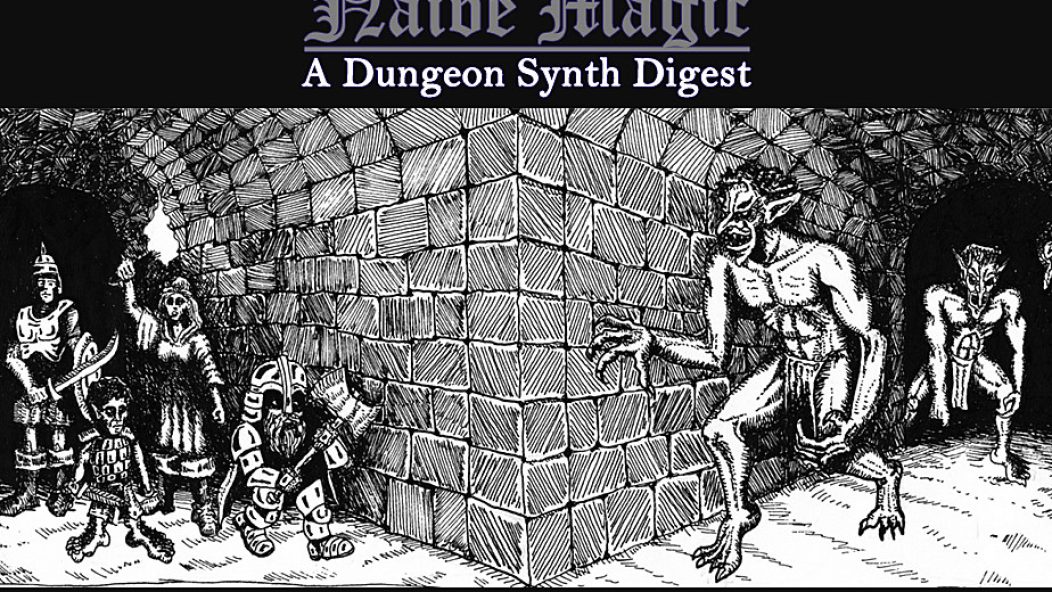
Naïve Magic: A Dungeon Synth Digest #5: Dungeon Synth & Dragons
DS&D: The Intersection Between Music and Gaming
Dungeon synth has always been tied to fantasy in terms of its thematics and general approach to making music. Whether or not it is a vague pastiche of fantasy atmosphere or something that comes with a specific narrative, an immersion in fiction is a central component to its music. While an interest in fantasy does not necessarily dictate an interest in gaming, the worlds of fantasy and gaming have more of a distinct throughline if not a paved road. This is why I feel the world of dungeon synth lends itself to interactive gaming and why I could see its medium being a vessel for a deeper exploration in audience participation. Dungeon synth has already been hitched to the act of gaming even if it is in a passive manner, and I feel it is just a matter of time until we have more of a blended medium.
Since tabletop games such as Dungeons and Dragons lend themselves to people gathering together to play at a table, atmospheric music is a popular component for the experience. On Spotify or Youtube you can search for tabletop game music for towns, battles, exploration, or any other situation where music would be needed. Dungeon synth, an entire genre of instrumental fantasy ambient, seems like it was almost built to be incidental music in a gaming experience, as its dedication to atmosphere falls in line with the Dungeon Master’s job. In 2014, the artist Erang released a compilation video titled “2 hours of Dungeon Synth & Fantasy Music by Erang.” While it does not state it is for gaming, two hours of instrumental dungeon synth was almost built for the purposes of a tabletop adventure and I, as well as many others, heavily used this video for my tabletop games. Dungeon synth seemed to be made to provide the backdrop for adventure and exploration.
…
…
In fact, Dungeon Synth artists have dedicated themselves to creating soundtracks to games. For example, Synth Bard created flavorful (yet not mechanically useful) character sheets for 2015’s Gold Box Renditions, which was a tribute album to the music from an Advanced Dungeons and Dragons computer game available from 1988 to 1992. Synth Bard would go on to create unofficial soundtracks for old Dungeons and Dragons modules such as Ravenloft, Beyond the Crystal Cave, and The Isle of The Dead. The listener would use the album to provide music for each room the party would explore, thus giving these albums an integrated agency when it came to narration and use. This is where I feel dungeon synth could travel as an instrument for mood that is wielded by the listener. While the traditional dichotomy between listener and performer will not change completely, the blurring of the stratum where the listener is a performer in the production, and thus can dictate their own experience, is intriguing and something I feel could be an avenue to be explored. Already in 2021, there are great strides into a future with integrated music and gaming.
…
When writing the feature on Heimat Der Katastrophe (HDK) for last month’s digest, I was struck by the depth of integration for SPEEDWAY’s Deathblow. Presented as a soundtrack to the Deathblow RPG, this cassette release came with quick start rules and a cutout where one could fold and glue a paper 4 sided dicer. The game, created by Henry M. Richardson, seems entirely tied to this album as the promotion material for Deathblow is also accompanied by the SPEEDWAY soundtrack. While more aesthetic than practical, the music is a vehicle that urges the listener to participate in the world created by the game, as well as an aid for further exploration. This is not the only nor the latest integration by HDK in terms of game advertisement or even integration, as the label has been working tirelessly to promote forgotten or new game systems that are bootstrapped to their releases. The DIY aesthetic that is attached to these releases makes it even more intriguing.
…
In 2021, Desolation Plains released Sword of Hailstone, a debut album that came alongside a companion solo hex crawl game of the same name. Sword of Hailstone was to be played via a companion phone app and integrated into the popular Mork Borg rules system for its core gameplay. Sword of Hailstoneis both the soundtrack to the game and the addendum to the album. The phone app itself was to be modeled after the point and click adventure computer games of the 80’s and 90’s and had the player wandering around an icy world in search of the fabled Sword of Hailstone. It is a delightful and fascinating tribute to old computer games as well as a step forward in game immersion. The artist’s second record False Prophecies, for a while was not available for preorder; rather one could find the download code in the game. False Prophecies, at the time of this publication does have a tape order which comes with a new adventure with the same game model. Sword of Hailstone and its followup is perhaps one of the most integrated experiences, with many extensions required to immerse oneself in the music completely. However, one does not have to traverse these depths to enjoy the album, rather it is for those willing to travel for a new experience.
…
Vicious Mockery, a label named after a Dungeons and Dragons spell, celebrated their anniversary with Wizard’s Brew, a compilation of new dungeon synth music from their roster. To commemorate their love for gaming, the tape came with a pencil, a 12 sided dice, and a full tabletop RPG intended to be played with the soundtrack. Wizards Brew, the game, was created specifically for the compilation and fully encapsulates the love for audience interaction. In the tradition of one page RPG systems, Wizards Brew is a fun experience that hinges on wild and unpredictable encounters. The label, much like the game, is a showcase for wild and unpredictable music, and I hope for more blending of experiences like this in the future.
While many records and labels in the dungeon synth arena have made strides to successfully blend music and gaming, there is still work that needs to be done. In 2007, the indie pop trio Morning Bell released Through the Belly of the Sea: A Choose Your Own Adventure Album. This record changed the structure of a traditional album and turned it into a gamebook where the listener was in charge of dictating the narration of the record by selecting the track order. This record, while novel, failed to excite most people. Instead of fanfare for the idea, the album was met with general dislike for it’s attempt to incorporate the title and thematic design of the nostalgic children’s gamebook series. The failure of Through the Belly of the Sea happened for many reasons but may illuminate the wide distance between the passive art of listening and the active art of participation. I can still fathom a future where games and music are interwoven but I understand their disjunction. Music and games might be still separated by a considerable distance, but in 2021 small paths are being made between. I hope for more in the future but I think I can manage if we just have some amazing music.
…
Witchsteel comes to us from the US with a 2020 rerelease that is being repackaged by Gondolin Records. I have already sung the praises for Gondolin and I will continue to do so as long as they continue to showcase amazing acts making music. Mountain of the Red Flame is the only release from Witchsteel and for a debut, it is striking in its competency. Worshipping the sounds of classic dungeon synth such as Depressive Silence, Witchsteel surrounds themselves in fantasy sound clips and mournful synths that resonate over lonely mountains. The creator is even pictured on their Bandcamp in black metal makeup wielding an axe in a tree. While this sounds strange and possibly ludicrous, Witchsteels’ resolve for tradition in both sound and style is a testament to the album’s quality.
…
Hewer of Caves comes to us from Tennessee, which is also the origin place of Big Tobacco Records. Big Tobacco Records has put out some of the most idyllic tapes of the past year, as well as some of the strangest things I’ve heard in recent memory. Cutting of the Calyx fits into the former camp with a record of pure bliss reminiscent of video game music or low key questing music suitable for an adventure novel. I was struck by how much I enjoyed this sound and how lush one could be while still immersed in haze. Following the tradition of bedroom medieval ambience, Cutting of the Calyx walks the path of artists such as Erang and Lord Lovidicus with a release that is intimidating in its completeness. Cutting of the Calyx is the first release from Hewer of Caves in 2021 following a handful of releases in 2020. I am glad for this particular release to be highlighted as I feel it is one of the project’s strongest and perhaps a great stepping stone into the world of Hewer of Caves / Big Tobacco releases.
…
Nibelung, as well as Stench Ov Death Productions, has been in the business of dealing tapes in esoteric packages. While previous Nibelung albums came wrapped in paper sealed with wax, this is the first time a release has come in a log. In an edition of five, The Lonely Wood comes housed in a sawed log complete with clamping mechanism perfect for absolutely no tape rack in existence. This conspicuous packaging compliments a bizarre record that is composed of synthless field music recorded live with bells. While this whole production could turn into a parody, Nibelung’s care and craft regarding the record makes it a fantastic exploration into minimalism and field recordings. The artist is also very up front regarding the special release packaging. While you do not need to spend money on the log to listen to this, it is fun to know that it is out there for five special people to house somewhere other than a cassette rack. The Lonely Wood is of particular interest to people in the art of field recording and raw production, as this release not only pushes the envelope of packaging but also sound. Nibelung, as well as Stench Ov Death Productions, continues to challenge convention with a release that will be a conversation starter for a select few.
…
Poseidonis is the debut from French composer Arcanist. Instead of following the traditional release path this album skipped both the digital and cassette tape releases and went with an elegant vinyl edition. If a vinyl debut was not enough to pique interest, then the heavy worship of Berlin School electronics and proto dungeon synth artists like Jim Kirkwood should be enough to make one pause and reflect in the vast seascape. I have already expressed my undying love and devotion to this type of progressive sound as I feel it provides a wide avenue for dungeon synth to experiment. Moody and evocative, Poseidonis takes inspiration from the weird fiction of Clark Ashton Smith and transforms it into a cinematic experience that is intimidating for only a debut. While including dark ambient undercurrents throughout the record, Poseidonis is both engaging and unsettling toward its participants. It is the perfect sound for a vinyl debut into the dark.
Finding Sage of Seers and its tape debut is one of the reasons why I love this genre so much. Here, among thousands of releases, was an unassuming debut that I casually picked up. Without much fanfare or press, Watching From Within is a devastatingly gorgeous release that is both medieval in its spirit and serene in its execution. For fans of idyllic dungeon synth with a sense of sadness, Watching From Within might be a bedroom record with restrained production yet the record travels across vast distances with endless imagination. Full soundscapes are crafted with just a synth leading to tapestries of melodies which evoke many emotions. It is difficult sometimes to grasp the enormity of releases that happen almost every day, but it is wonderful to come in contact with a release that is still hiding out quietly away from everything else.
…
I have discussed Water Nymph and Grimestone Records in my first digest and, usually, I do not like to write about the same artist twice, however, I cannot ignore this sound. When you enter the world of Grimestone, you surrender yourself to madness and excitement. Woozy and narcotic, Water Nymph offers soft synth with idyllic sounds that sound like they are being played from the bottom of a pool. Precious Sunrise might be the fullest realization of Water Nymphs attempt to play dungeon synth with a hallucinatory sensibility as its melodies approach the sound of new age but in playful low fidelity. This short album is the third offering from the artist and continues their exploration into a world where the sea creatures hold court in magical kingdoms. If the idea of a procession of octopuses riding a cavalry of seahorses is intriguing, then the enchanted sounds of dungeon synth gone weird might be for you.
…
High Mage Productions is strange and delightful. It is a wonderful thing to find a label that puts out some of the more ill-fitting and off the wall releases, with more than one artist with food in their name. Elminster isn’t as strange as some of the roster, like Taco Truck or Cloak Bong, but this US artist seems to be down to hang with weirdos. Elminster has already had three outstanding tape releases from labels like Vicious Mockery, Moonworshipper, and Voices and the Anuir. Antipaladin is the continuing path of the artist as they construct a kingdom of lo fi haze set in the year 2525. Antipaladin might be one of the more complete and accessible releases from the artist, as it offers the sounds of Tangerine Dream that feels nostalgic yet still futuristic. Elminster continues to build their reputation as a mage of fog, light and shadows, content in their workings with a band of wandering jesters.
…
Ghoulmire is another resident of the kingdom of haze, yet this UK artist surrounds themselves with ghosts and memories of the past. Mount Fitchet is the third demo from the artist under the Ghoulmire name, who uses Barghast as an alternate name for other projects. With audible production noise and intentional recording distortion, Mount Fitchet warbles in a spectral display of warped synth over forest ambience. While this sound might be odd to some, Ghoulmire’s craft in delivering symphonies that sound like they are from dusty crypts has always amazed me with their sound.
…
The label Realm of Sleep is a collection of projects from creator J Brown. The Obsolescent Arborist is one of the 20 different mantles taken up in the Realm of Sleep. If one has followed any of these releases, one is aware they appear on the artist’s Bandcamp with little fanfare and come on stunning minimally designed monochrome tapes that I never seem to get a copy of. The Obsolescent Arborist is the second release from the project and offers its listener a world of bleak hope and track titles named after species of trees. Compared to the project’s debut in 2018, The Obsolescent Arborist, is an incredible step forward in terms of production with the same sort of melancholic haze but with its melodies peeking through the land of grief and sorrow. These two short songs constitute great strikes made in this Realm of Sorrow. The Obsolescent Arborist, as well as all of the citizens in the Realm of Sleep stand in shadows waiting for the next visitor to come to their humble abode.
…
This is it. The weirdest thing I found this month. Le Syndicat Des Scorpions is a label that has some of the most outrageous tapes I have ever seen and heard, and I have fallen head over heels for this collective. Les Cris de Mélusine from the act ARKANAR was my guide into this playful and bizarre marketboard of sound. Imagine a bunch of lo-fi, bedroom pop, noise, techno, synthpop, and outsider kids all go away to art school but instead of going to class they just drink coffee and write collaborative fiction early in the morning. With that image, one is halfway to the majesty of Les Cris de Mélusine as this is the sound of Jean Jacques Perry going to the Renaissance Fair and having a blast. I have been fascinated by Les Cris de Mélusine and finding it was like coming home to a family of ragtags that always has their door open.
…










